The iPhone 4 Redux: Analyzing Apple's iOS 4.0.1 Signal Fix & Antenna Issue
by Brian Klug & Anand Lal Shimpi on July 15, 2010 12:28 PM EST- Posted in
- Smartphones
- Apple
- iOS 4
- iPhone 4
- Mobile
In case you haven’t noticed, the iPhone 4’s antenna design has come under considerable scrutiny. In our iPhone 4 review, we investigated the iPhone 4 antenna and came to two conclusions. First, that iOS 4 was displaying signal bars in an overly optimistic manner, compressing the dynamic range of possible signal bars users can see. Second, we identified a worst case signal drop of around 24 dB when the iPhone 4 is cupped tightly in the left hand, covering the black strip and possibly detuning the antennas and adding additional attenuation from the presence of the hand.
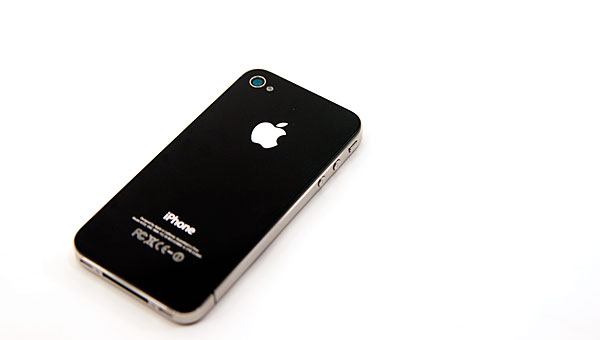
Since those initial measurements, we’ve been working tirelessly to both characterize the problem, fully understand the mechanisms behind it, and report on a number of possible solutions.
The Bars Have Changed
On July 2, Apple released a letter noting that the formula used in iOS 4.0 to calculate how many bars are presented for each signal strength is “totally wrong.” This mirrored our conclusions that the effects of the signal drop were exacerbated in part by the way the iPhone visualizes signal strength - the dynamic range is compressed so much that the 24 dB drop from cupping the phone without a case could make all the bars go away.
They went on to promise that in a future software update they would make bars 1, 2, and 3 taller, and make the bars more “accurate” by displaying 2 bars fewer in certain circumstances.
iOS 4.1 beta rolled around yesterday, and we immediately dove in to find out just how much the bar to signal strength mapping has changed. Update: iOS 4.0.1 final just came out this afternoon and we finished preliminary testing. The signal strength mapping algorithms are identical to the 4.1 beta. The findings in this article apply to 4.0.1 as well as the 4.1 beta.

After updating our devices to the iOS 4.1 beta (and 4.0.1) and making sure our little trick to show signal strength in dBm instead of bars still worked, we set off. Remember last time how I said I drove around town all day with iOS 4.0, testing the phone, and recording signal strength and how many bars were being shown? You guessed it - another update, another evening of driving around. Anand and I did quite our fair share of moving around to get a complete picture of what the new cutoffs are.
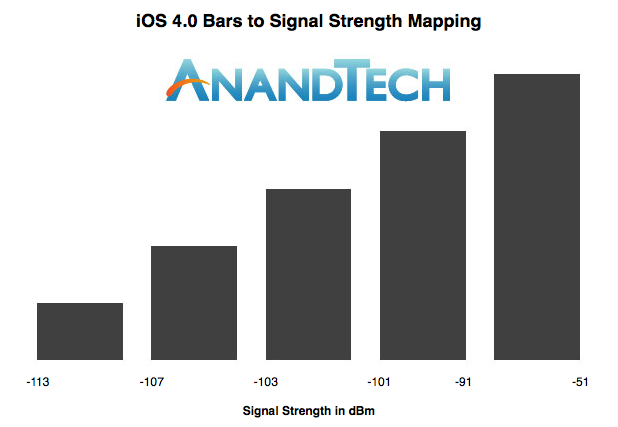
Old Bars
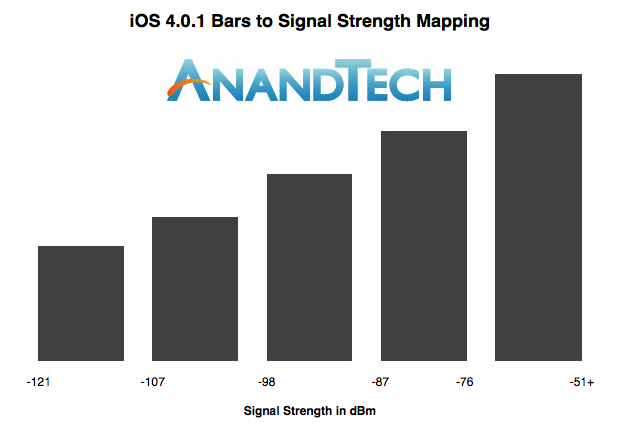
New Bars
The results are conclusive - Apple has dramatically changed the signal strength to signal bar mapping in iOS 4.0.1 and the iOS 4.1 beta, making the dynamic range not only much broader, but the range values for each bar much wider. The range of signals that correspond to bars three and four are the same width, and bar two is only slightly less.
The cutoff value for two bars to one bar remains the same, but every other value has increased. The result is that the worst case drop of 24 dBm no longer makes all the signal bars disappear, but rather two.
AnandTech reader Mike Escoffery, Director of Design and User Experience at Media Platforms, created his own diagram to help compare the old and new way of iOS signal strength reporting:
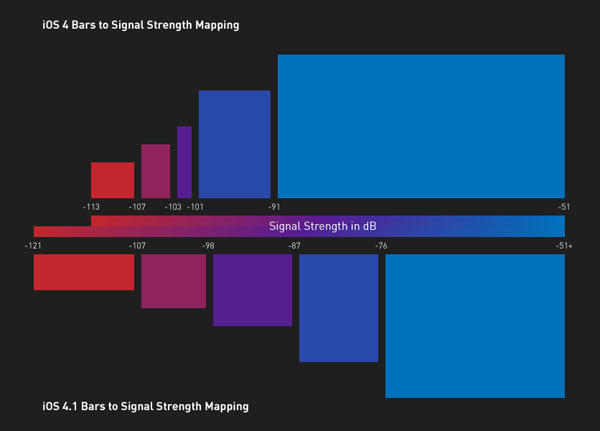
As you can see the old way (top) put far too much weight into the 5th bar of signal. Apple's new approach not only splits it up more reasonably between the 4th and 5th bar (still non-linearly keeping you in the 5th bar if possible) but also extends the range of the lower bars.
This change actually presented itself in our numeric signal strength reports - there’s more dynamic range in these numbers too. Previously, the absolute lowest value any iPhone would report was -113 dBm. With iOS 4.0.1/4.1, the value is now a shockingly low -121 dBm. In the iPhone 4 review, I talked a lot about how although the phone is prone to dropping signal from being held wrong, it was measurably more sensitive in weak signal areas. I was shocked that calls and data worked seemingly unfazed at -113 dBm. It seems as though this increased 8 dBm of range below -113 dBm was meant to show really how much more sensitive the radio stack is - it undeniably is more sensitive. Both Anand and I were able to hang onto calls all the way down at -121 dBm.
We’ve also included a comparison to how the latest version of Android displays signal bars from GSM or UMTS networks below. Thankfully, this didn’t require driving around town all day but rather inspecting the latest version of the Android source code from Google’s own repositories. Android uses an ASU value to compute signal strength, which isn’t anything more than a remapping of dBm to a sane value that’s a bit easier to interpret.
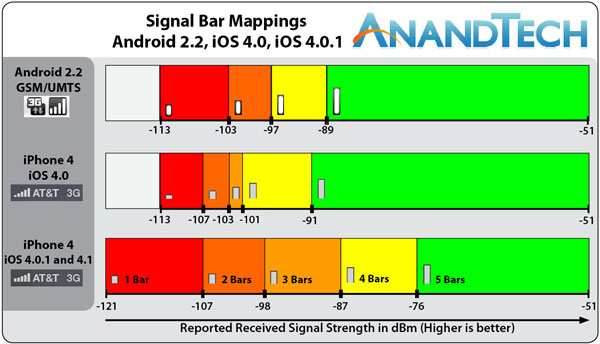
Apple’s mappings have gone from having probably the most compressed dynamic range among handset vendors to less compressed than Android.
While the software update obviously does not and cannot address the design of the antenna itself - or make the drop from holding the phone any less - it does change the way the issue is perceived among users. The result is that most iPhone users will see fewer bars disappear when they hold the iPhone 4 in a bare hand. The side effect is that the iPhone now displays fewer bars in most places, and users that haven’t been reporting signal in dBm will time see the - perhaps a bit shocking - reality of locations previously denoted as having excellent signal.
Interestingly enough, Apple has indeed changed the heights of bars 1, 2, and 3. They’re taller, and the result is that the relative heights are no longer linear, but rather a tad exponential looking. It’s a mind trick that Apple no doubt hopes will make the signal look better. If the bars are taller, they must denote stronger signal, right?
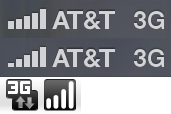
From top to bottom: iOS 4.1, iOS 4.0, Android 2.2
The reality is that Apple likely wants to deflect at least some of the initial backlash AT&T will face for reporting the signal bars without any concessions. Concessions that used to make coverage look better than it really is. Regardless of how tall the bars are, there are still going to be fewer of them virtually everywhere. Interestingly enough, while bars 1 and 2 are the most changed, their respective cutoffs are virtually unchanged.
While I was testing iOS 4.0.1, I told Anand that the signal reporting lie that started with the iPhone 3G had been removed entirely. That iOS 4.0.1 would potentially show the reality of AT&T’s coverage to iPhone users. With 4.0.1 users looking at signal bars will get a much more realistic view of how signal is changing.
We tested the iOS 4.1 beta on iPhone 3GSes as well, and found the mappings to be the same there as well.










146 Comments
View All Comments
SharksFan - Monday, July 19, 2010 - link
They probably just read the article and realized they were as well off with an iPhone 4 signal wise vs the compared Nexus One, so they stopped worrying.-121db cutoff and -24 signal attentuation means the phone should be good till -97db on average, before you grab it hard.
-121 cutoff and -20 signal attenuation means the phone should be good till -101db on average.
-97db vs -98db when compared to Nexus One when held "hard", and -101 v -102 when compared to Nexus One when held "normally".
Those are pretty much identical cutoff's btw.
So I guess you should be clamoring for a Nexus One recall too....
Maybe we can sue Google?
leexgx - Friday, July 16, 2010 - link
i did not even read that commentgilesrulz - Friday, July 16, 2010 - link
First, thank you for your two well reasoned and reported articles on this subject. Would you be willing to update the article to discuss Apple's indication that attenuation caused by conductivity is not the issue, and that it is caused by the normal physics of being meat bags?steve.h - Monday, July 19, 2010 - link
Yes! This is exactly what I am also wondering, and something I haven't seen addressed anywhere else. If the problem is mostly due to the conductivity of the skin interfering with the antenna, Apple hasn't been completely truthful in comparing their problems with problems faced by other manufacturers. It seems like a fairly simple test to perform, I am surprised none of the tech blogs I read have tried to address this yet. Of course anandtech is the only place any actual information gathering was done and reported in the first place, most of the rest was just fear mongering.Again, I am convinced that this is a non-issue either way for most users, since it only affects performance in a small number of cases. However, I'd be interested to see if Apple really was being intentionally misleading in their press conference by comparing their issues to other manufacturers.
atomez - Friday, July 16, 2010 - link
I got an iPhone 3G with OS4 (iPhone 4 no yet available here) and the same "grip of deat" happens! It usually got 5 bars signal strenght. Using the left hand GOD it dropped to 2 bars. Now with OS4.1 it shows 3 bars and drops to the same 2 bars on GOD. And you know what? It never dropped a call! So it's working fine for me. I understand the iPhone 4 will be the same.It's not a problem, it's a feature. Get used to it.
No one is fooling you. If you don't like it, just don't buy it. If you have it, go get the free bumper. Or just return it and get your money back.
Polakapalooza - Friday, July 16, 2010 - link
Essentially, then, you are equating — and, it appears, correctly so — the iPhone 4 with Henry Wadsworth Longfellow's "little girl," to wit:There was a little girl,
Who had a little curl,
Right in the middle of her forehead.
When she was good,
She was very good indeed,
But when she was bad she was horrid.
jms102285 - Friday, July 16, 2010 - link
Might I recommend to the readers who are upset at the passive-apple/anti-MS dynamic here an alternative:http://www.boygeniusreport.com/
For the past few years I have been coming here for the news on the latest/greatest reviews digging into the meat and potatoes of cutting edge hardware. Lately I've been very very disappointed at the disproportionate amount of content regarding Apple vs. the release of other new phones.
I understand that website hits lead to more advertising revenue and that Apple news gets hits, but couple that with the dare I say passive nature towards Apples mistakes versus other manufacturers' mistakes and it really hurts the integrity of what I come here for.
I also have been less than happy with the IT computing section as they really don't discuss much there. It seems like an afterthought compared to other sections of the site.
So peace out Anand, good luck here.
SunSamurai - Friday, July 16, 2010 - link
You wont be missed.Running off because of one too many apple related articles. Talk about childish.
screensurfer - Friday, July 16, 2010 - link
Just a few of things I noticed:1) Apple found 3 phones that have similar problems. Fine. I can find a dozen that don't have such "grave" problem. The problem with iPhone 4 is that its attenuation is "a record" for a smartphone when the hand touches it.
2) Apple took 22 days to find that the solution... is to patch it with a case. Bah!
3) AppleCare data: it's flawed in 2 ways: First, they should only present it when the 30 days are over, to have a more apples-to-apples comparison vs. 3GS (who's data might not be the same time period). Second, the fact that iPhone 4 is a much better device than 3GS: people are holding to them. Regardless, this is not an excuse to keep a design flaw.
4) ATT returns rate only. Where are Apple stores numbers? Could they show a different figure? I believe so, otherwise Steve would have shown their own numbers.
5) (My favorite lie with numbers technique): Average cell phone drops 1 call per 100. If iPhone4 drops <1 pp more than 3GS, it means that it drops up to more 100% more calls than 3GS!!!!!!!
6) They have figured out a better hardware that prevents this, they're just unwilling to recall the inicial production. Why? First, 30th September deadline; second, Steve implied it during the presentation that they were working on a hardware fix that "defies physics".
Please don't lie with numbers. I hope this helps to clarify the PR BS!
Snotling - Friday, July 16, 2010 - link
"Steve implied it during the presentation that they were working on a hardware fix that "defies physics"."yeah, I'm sure Steve Jobs will try hard to defeat the laws of physics...
do you realize how silly you sound?